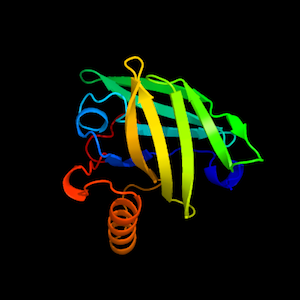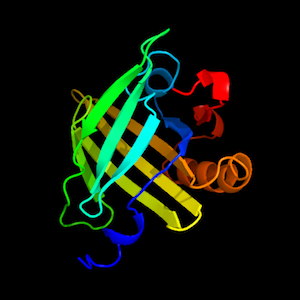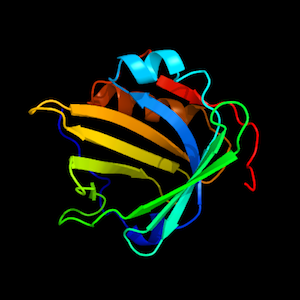Lipocalin laboratory
 Associate Professor
Associate Professor
Bernhard Redl
email: bernhard.redl[at]i-med.ac.at
Group members
CV
 |
 |
 |
Structure and Function of Lipocalins and their Cellular Receptors
The protein superfamily of lipocalins consists of small, mainly secretory proteins defined on the basis of conserved amino acid sequence motifs and their common structure. Functionally, they were found to be important extracellular carriers of lipophilic compounds in vertebrates, invertebrates, plants, and bacteria. There is increasing evidence that this group of proteins is involved in a variety of physiological processes including retinoid, fatty acid and pheromone signaling, immunomodulation, inflammation, detoxification, modulation of growth and metabolism, tissue development, apoptosis and even behavior processes. Whereas the structural basis of lipocalin-ligand binding is now well understood, there is a major lack of knowledge regarding the mechanisms by which lipocalins exert their biological effects. This is mainly due to the fact that only limited data are available on lipocalin receptors and lipocalin-receptor interactions, although it is well accepted that many, if not all, of these proteins are able to bind to specific cell receptors.
Research projects of our lab focus on the following subjects:
- Identification of cellular lipocalin receptors and characterization of the biological processes beyond receptor binding.
- Evaluation of novel functions of lipocalins in innate immunity and allergy.
Service unit: Microbiome analysis
Analysis of bacterial community composition (microbiome) was larged enhanced by the method of bacterial metagenomic sequencing. This method is now widely used for investigations of bacterial communities present in humans, animals, plants and environmental samples, including soil and water systems. We offer this service on special request (Bernhard.Redl@i-med.ac.at).
Selected Publications
-
Redl B., Holzfeind P. and Lottspeich F. (1992) cDNA cloning and sequencing reveals human tear prealbumin to be a member of the lipophilic-ligand carrier protein superfamily. J. Biol. Chem. 267, 20282-20287.
-
Redl B., Merschak P., Abt B. and Wojnar P. (1999) Phage display reveals a novel interaction of human lipocalin LCN1 and thioredoxin which is relevant for ligand binding. FEBS Lett. 460, 182-186.
-
Lechner M., Wojnar P. and Redl B. (2001) Human tear lipocalin acts as an oxidative-stress-induced scavenger of potentially harmful lipid peroxidation products in a cell culture system. Biochem J., 356, 129-135.
-
Wojnar P., Lechner M., Merschak P. and Redl B. (2001) Molecular cloning of a novel Lipocalin-1 interacting human cell membrane receptor (LIMR) using phage-display. J. Biol. Chem., 276(23), 20206-20212.
-
Wojnar P., Lechner M. and Redl B. (2003). Antisense downregulation of the lipocalin-interacting-membrane-receptor expression inhibits cellular internalization of Lipocalin-1 in human NT2 cells. J. Biol. Chem, 278, 16209-16215.
-
Breustedt D.A., Korndoerfer I.P., Redl B. and Skerra A. (2005) The 1.8 A crystal structure of human tear lipocalin reveals an extended branched cavity with capacity for multiple ligands. J. Biol. Chem. 280, 484-493
-
Fluckinger M., Haas H., Merschak P., Glasgow BJ. and Redl B. (2004) Human Tear Lipocalin exhibits antimicrobial activity by scavenging of microbial siderophores. Antimicrob. Agents Chemoth. 48, 3367-3372.
-
Fluckinger M., Merschak P., Hermann M., Haertle T. and Redl B. (2008) Lipocalin-interacting-membrane-receptor (LIMR) mediates cellular internalization of beta-lactoglobulin. BBA-Biomembranes 1787, 342-347.
-
Leal SM., Roy S., Vareechon C., Clark H., Carrion S., Lopes-Berges MS., di Pietro A., Schrettl M., Beckman N., Redl B., Haas H. and Pearlman E. (2013) Targeting iron acquisition blocks infection with the fungal pathogens Aspergillus fumigatus and Fusarium oxysporum. PLOS Pathogens, 9(7):e1003436
-
Staudinger T., Redl B. and Glasgow BJ. (2014) Antibacterial activity of rifamycins for M.smegmatis with comparison of oxidation and binding to tear lipocalin. BBA-Proteins and Proteomics 1844, 750-758.
-
Posch B., Irsara C., Gamper F., Herrmann M., Bindreither D., Fuchs D., Reider N., Redl B., Heufler C. (2015) Allergenic Can f 1 and its human homologue Lcn-1 direct dendritic cells to induce divergent immune responses. J.Cell.Mol.Med, 19, 2375-2384.



